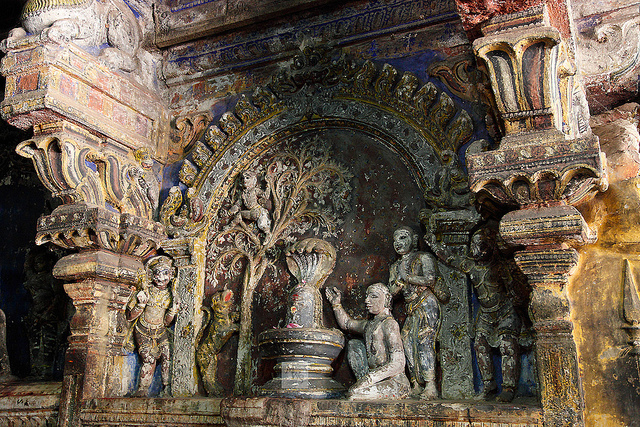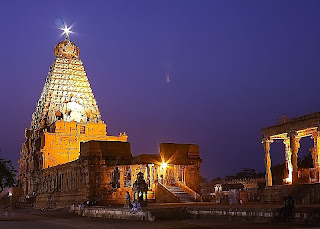Brihadeeswarar Temple, Thanjavur, Tamil Nadu, India - c1880's, Brihadeshwar temple or the Big temple is the
prime attraction of Thanjavur. Brihadeshwar temple was built in the early 11th
century by Rajaraja Chola I. The temple is built in Dravidian style of
architecture in granite.
 |
| Brihadeeswarar Temple, Thanjavur, Tamil Nadu, India - c1880's |
Brihadeshwar temple, known also as Rajarajesvaram, is one of the well
preserved Heritage Sites in Tamil Nadu. The temple dedicated to Lord Shiva has
a 2.7 m high Shivalinga, which is about 7 m in diameter. The construction which
encloses sanctum sanctorum is known by the name 'Periya Kovil' or the ‘Big
temple’. The 70 m high ‘Vimana’ of the
temple is built in such an architectural precision, that its shadow never falls
outside itself. The Shikharam, which
weighs about81.25 tons, is carved out of a single stone.
Brihadeshwar temple also features a massive idol of Nandi (bull), the
mount of Lord Shiva. This idol, which weighs about 25 tons, has a height of
about 3.6 m, length of 5.94 m and a width of 5.56 m. This idol is seated in ‘Nayak Mandapam’,
which is decorated with intricate carvings. The ceiling of this mandapam is
noted for its 1000 year old frescoes. Portraits of Sevappanayakan and his son
Achyutappa Nayak (the early Nayak rulers) can also be seen on the front pillars
of Nandi Mandapam.
History:
An inscription at the
temple
 |
| Main Gate Brihadeeswarar Temple, Thanjavur, Tamil Nadu, India |
The temple had its foundations laid out by the Tamil emperor
Arulmozhivarman, popularly called Rajaraja Chola I, in 1002 CE, as the first of
the great Tamil Chola building projects. It was built to grace the throne of
the Chola empire in compliance of a command given to him in his dream. The
scale and grandeur is in the Chola tradition. An axial and symmetrical geometry
rules the temple layout. Temples from this period and the following two
centuries are an expression of the Tamils (Chola) wealth, power and artistic
expertise. The emergence of such features as the multifaceted columns with
projecting square capitals signal the arrival of the new Chola style. The
Brihadeeswarar Temple was built to be the royal temple to display the emperor's
vision of his power and his relationship to the universal order. The temple was
the site of the major royal ceremonies such as anointing the emperor and
linking him with its deity, Shiva, and the daily rituals of the deities were
mirrored by those of the king. It is an architectural exemplar showcasing the
pure form of the Dravida type of temple architecture and representative of the
Chola Empire ideology and the Tamil civilisation in Southern India. The temple
"testify to the brilliant achievements of the Chola in architecture,
sculpture, painting and bronze casting."
Construction:
Statue of Rajaraja
Chola Chola I who consecrated the temple
The wish to build a mammoth temple like this is said to have occurred to
Raja Raja while he stayed at Sri Lanka as an emperor. The esteemed architect and engineer of the temple was Kunjara Mallan Raja
Raja Perunthachan as stated in inscriptions found at the temple. The temple was
built per ancient texts called Vaastu Shastras and Agamas. He is the ancient
ancestor of the doyan of Vaastu Vedic architecture, the late Dr. V. Ganapti
Sthapati of Chennai and Mahabalipurim (architect of the 133' granite
Thiruvalluvar statue at the tip of south India). Members of his family still
live and practice the ancient art and science. The American University of
Mayonic Science and Technology was initiated by Dr. V. Ganapati Sthapati to
perpetuate the same form of architectural principles used by Kunjara Mallan
Raja Raja Perunthachan to build the Brihadeeswarar temple. The temple was built
using a measure of 1 3/8 inch called an angula (24 units equaling 33 inches called
a hasta, muzam, or kishku).
 |
| Inside view of Brihadeeswarar Temple, Thanjavur, Tamil Nadu, India - c1880's |
This temple is the first building fully built by granite and finished
within 5yrs [1004AD – 1009AD]. The solid base of the temple raises about 5
metres (16 feet), above which stone deities and representatives of Shiva dance.
The huge kalasam or Vimanam (top portion of the shrine) is believed to weigh
81.28 tonnes and was raised to its present height by dragging on an inclined
plane of 6.44 km. The big Nandi (bull), weighing about 20 tonnes is made of a
single stone and is about 2 m in height, 6 m in length and 2.5 m in width. The
presiding deity of lingam is 3.7m tall. The prakaram (outer precincts of the
temple) measures 240m by 125m. The outer wall of the upper storey is carved
with 81 dance karanas – postures of Bharathanatyam, the classical dance of
Tamils. The shrine of Goddess is added by Pandyas during the 13th century,
Subramanya Shrine by Vijayanagara rulers and the Vinayaka shrine was renovated
by Maratha rulers.
Temple
Deities
Shiva Lingam at the
temple
 |
| Mool virat Brihadeeswarar Temple, Thanjavur, Tamil Nadu, India |
The "moolavar" or prime deity of the Brihadeeswarar Temple is
Shiva. All deities, particularly those placed in the niches of the outer wall
(Koshta Moorthigal) like Dakshinamurthy, Surya, Chandra are of huge size. The
Brihadiswarar temple is one of the rare temples which has idols for
"Ashta-dikpaalakas" (Guardians of the directions) — Indra, Agni,
Yama, Nirṛti, Varuṇa, Vāyu, Kubera, Īśāna – each of whom
was originally represented by a life-sized statue, approximately 6 feet tall,
enshrined in a separate temple located in the respective direction. (Only
Agni, Varuṇa, Vāyu
and Īśāna are preserved in situ.)
Temple personnel[edit]
One of the 81 dance
postures
The temple was consecrated in 1010 CE by Raja Raja Chola I & in 2010
a celebration commemorated the temple's thousandth anniversary. The temple
maintained a staff of 1000 people in various capacities with 400 being temple
dancers Besides the Brahmin priests, these included record-keepers, musicians,
scholars, and craftsman of every type as well as housekeeping staff. In those
days the temple was a hub of business activities for the flower, milk, oil, and
ghee merchants, all of whom made a regular supply of their respective goods for
the temple for its poojas and during festival seasons. Moreover as evidenced by
the inscriptions that found in the compound wall of this temple, the temple had
always been serving as a platform for the dancers who excelled in the
traditional dance form of Bharatnatyam.
A view from the top, Thanjavur can be reached easily by road, rail and air. Tamil Nadu state
government runs frequent public buses from nearby Trichy, Chennai, Kumbakonam,
Pudukkottai, Pattukkottai, Tirunelveli, Karur, Nagapattinam, Coimbatore,Erode
and many other cities in the state. From the state capital Chennai, a National
Highway (NH 45-A) linking Chennai with Chidambaram, Mayavaram, Kumbakonam,
Thanjavur,Thiruvarur and Nagappatinam provides convenient access to tourists
who come to visit Thanjavur and the adjoining towns. There are also several
buses operated by private bus operators. Rail services are run by Indian
Railways from many cities across India including Chennai, Trichy, Coimbatore,
Erode, Tirunelveli, Madurai and Nagore. The train station is Thanjavur
Junction. Tiruchirapalli Airport is the nearest airport, located 65 km away.
One favor? Would you
throw a link somewhere back to ttp://vedictemplesin.blogspot.com? Pretty
please? Thanks

















0 comments:
Post a Comment